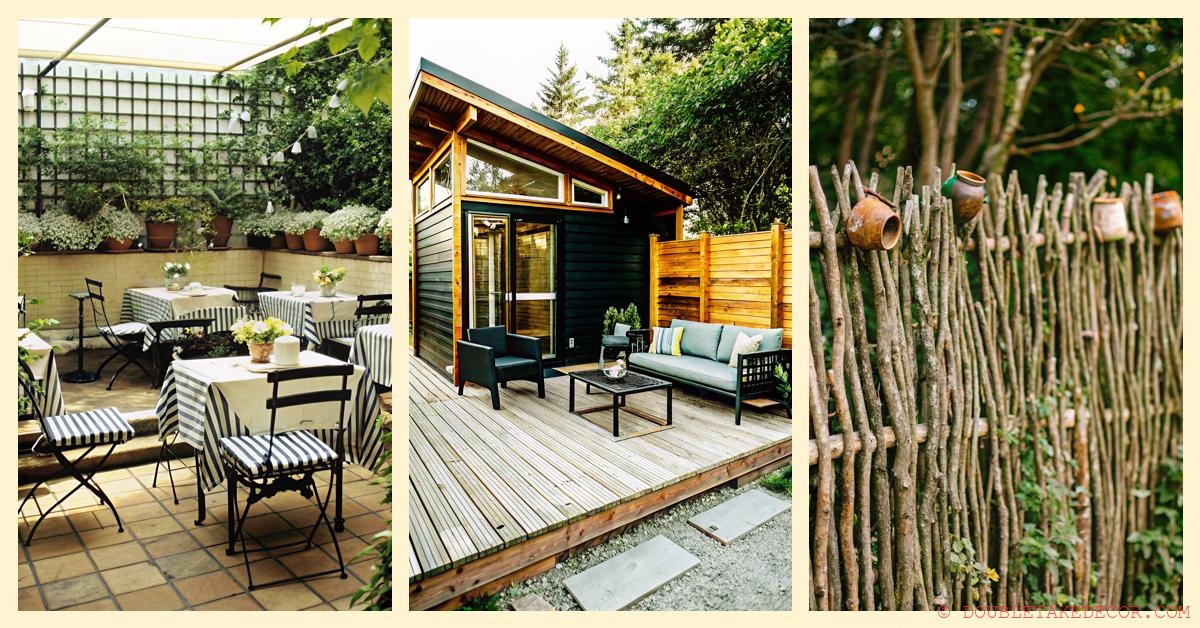
Garden edging is the art of creating distinct boundaries between different areas of your outdoor space, serving both practical and aesthetic purposes. This technique not only keeps soil and plants contained but also enhances your garden’s visual appeal while providing structure to your landscape design.
From plastic and metal to wood and stone, garden edging materials offer solutions for every style preference and budget. The right choice depends on factors like durability, maintenance requirements, and the overall look you’re trying to achieve in your garden.
Beyond its decorative value, edging plays crucial functional roles in the garden. It prevents soil erosion, manages water runoff, blocks invasive weeds, and simplifies maintenance by creating clear divisions between planting areas and pathways.
Whether you opt for scalloped terracotta edges that complement cottage gardens, sleek metal borders for modern landscapes, or natural plant boundaries for an organic look, the right edging transforms your garden into a well-organized, visually appealing space. With options ranging from professional installation to DIY projects and no-dig solutions, garden edging offers accessible ways to elevate your outdoor space while reducing maintenance and protecting your plants.
- 🌿 Enhance Garden Aesthetics: Garden edging creates distinct boundaries, improving both the visual appeal and structure of your outdoor space.
- 🛠️ Material Variety & Selection: Choose from materials like plastic, metal, wood, and stone based on your garden style, durability needs, and maintenance preferences.
- 🌱 Functional Benefits: Edging prevents soil erosion, manages water runoff, blocks weeds, and simplifies garden maintenance by clearly separating planting areas from paths.
- 🧑🌾 DIY & Customization Options: With options ranging from professional installation to no-dig solutions, garden edging provides flexible ways to enhance your garden’s appearance and functionality.
Blend Wood & Pebbles for Sophisticated Garden Pathway
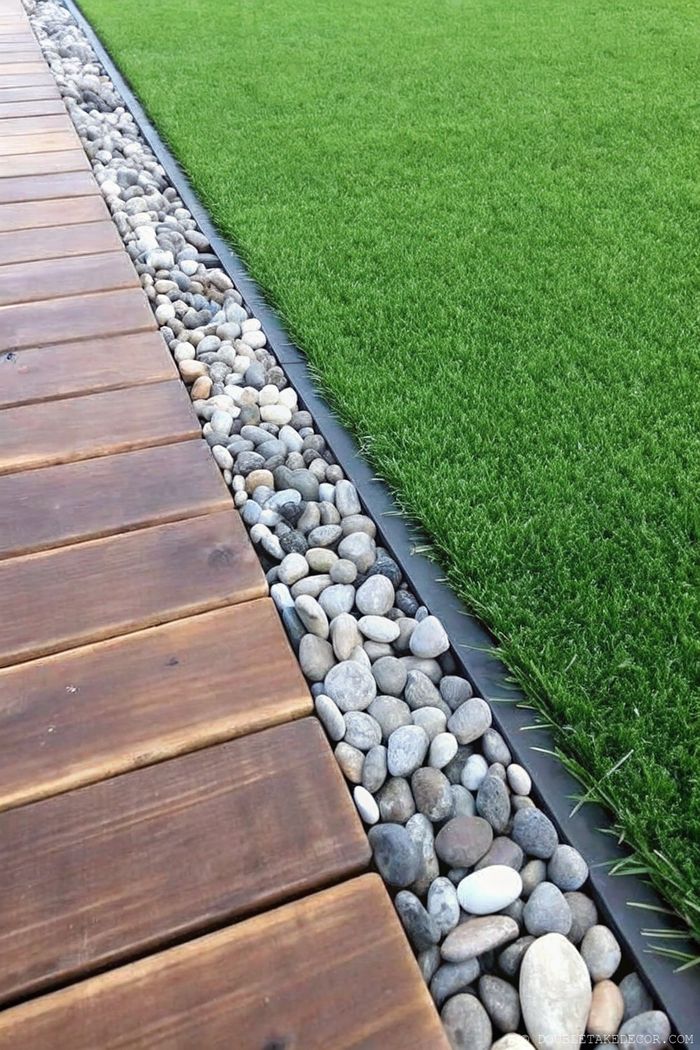
Create a striking visual contrast by combining wooden planks with smooth pebbles as a distinctive garden edge. Install the walkway slightly elevated above the pebble border for drainage and definition. This design works particularly well alongside artificial turf, requiring minimal maintenance while providing year-round structure. Use varying pebble sizes for added texture and visual interest.
Transform Concrete Blocks into Elegant Garden Edging Planters

Maximize garden space by repurposing concrete blocks as structured edging planters. Position them along walls or borders, fill with quality soil, and plant diverse flowers for visual interest. For optimal results, place taller blooms at the back and cascade down with shorter varieties. Complement with traditional pots to create depth and install solar garden lamps for evening ambiance.
Create a Timeless Stone Border for Dynamic Plant Textures

Edge your garden with a low stone wall to provide elegant structure and visual definition. Position taller conical evergreens as anchors, then surround them with variegated hostas for textural contrast. This permanent edging solution not only contains mulch effectively but also elevates your landscape design with minimal maintenance requirements. Use darker mulch to make plant colors pop against the stonework.
Create a Tranquil Stone-Lined Garden Path
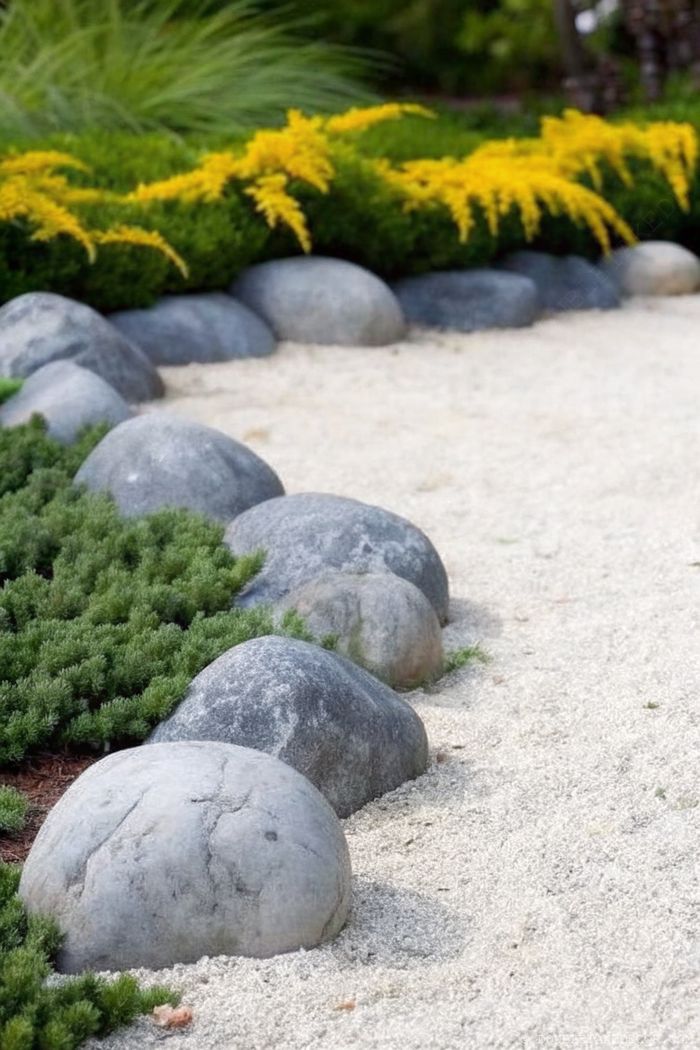
Use smooth, rounded gray stones of varying sizes to elegantly define your garden pathways. Place them strategically along sand-covered areas, allowing low-growing greenery to softly fill spaces between stones. For visual interest, plant bright yellow flowers nearby to create striking color contrast. This low-maintenance edging solution offers both practical definition and aesthetic appeal to your outdoor sanctuary.
Natural Log Edging for Vibrant Garden Borders
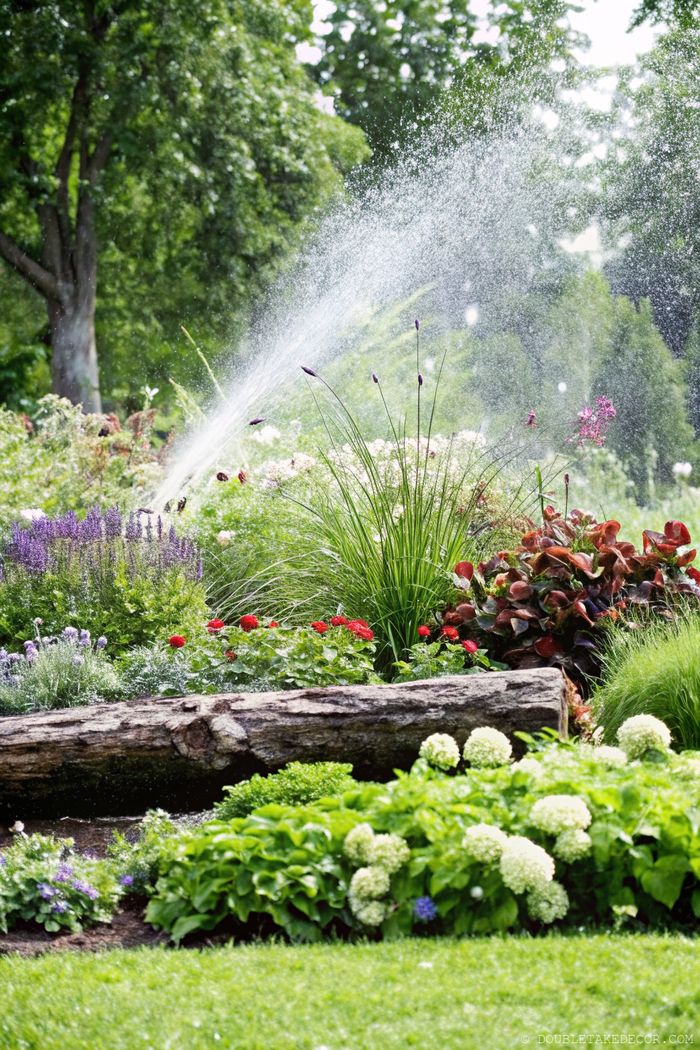
Integrate rustic wooden logs as garden edging to create a natural boundary for your blooming spaces. Position logs horizontally along borders to separate flower beds from lawns, allowing some soil buildup against them for a seamless look. Use pressure-treated or naturally rot-resistant wood like cedar or cypress for longevity. Water deeply around the edging to ensure flowers thrive.
Create Defined Garden Zones with Elegant Stone Border Edging

Install stone border edging to create clean divisions between your lawn and flower beds. Choose stones of uniform size for a polished look, or mix shapes for rustic charm. Lay them in a shallow trench for stability and prevent grass invasion. This durable solution requires minimal maintenance while highlighting your colorful plantings.
Create a Cohesive Garden Path with Contrasting Border Edging
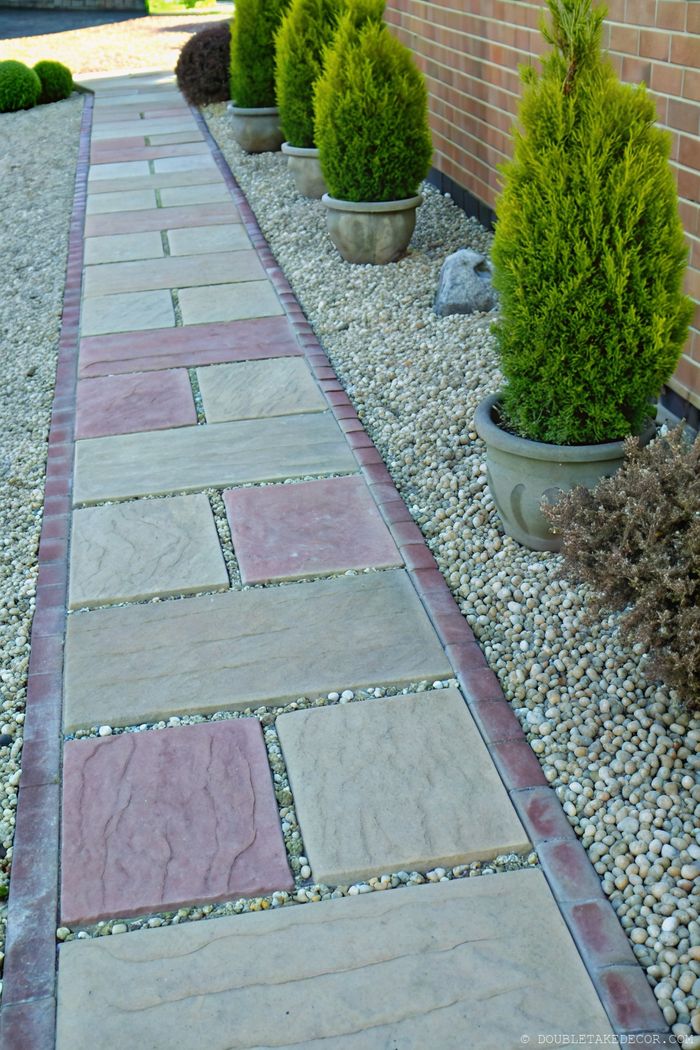
Install a thin strip of red brick edging alongside mixed paver stones for a sophisticated pathway design. Use contrasting colors to define walking areas while maintaining visual harmony. Position decorative potted plants strategically along the edges to soften the hardscape. Add small gravel beds between plantings for improved drainage and a textured finish that reduces maintenance needs.
Elegant White Rock Edging for Defined Garden Pathways
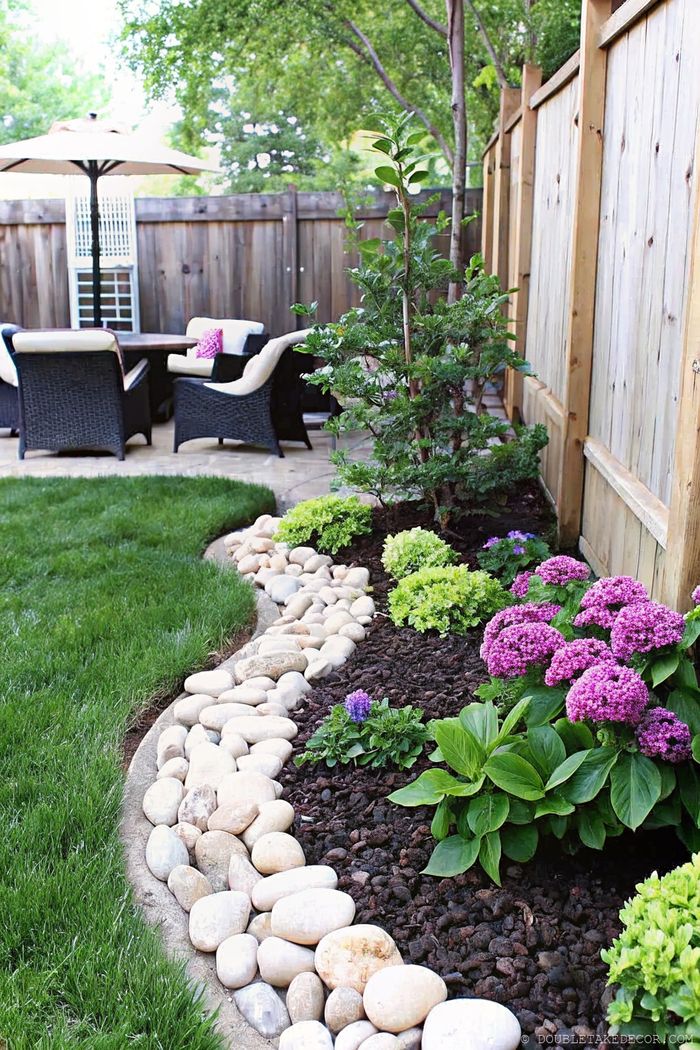
Create clear visual separation between your garden and pathway using smooth white rocks. This curved edging solution not only defines spaces beautifully but also prevents mulch spillover. Install rocks in a shallow trench for stability, ensuring they’re partially buried. For best results, use rocks of similar size and place landscape fabric underneath to minimize weed growth.
Create Functional Gravel Pathways with Wooden Border Edging
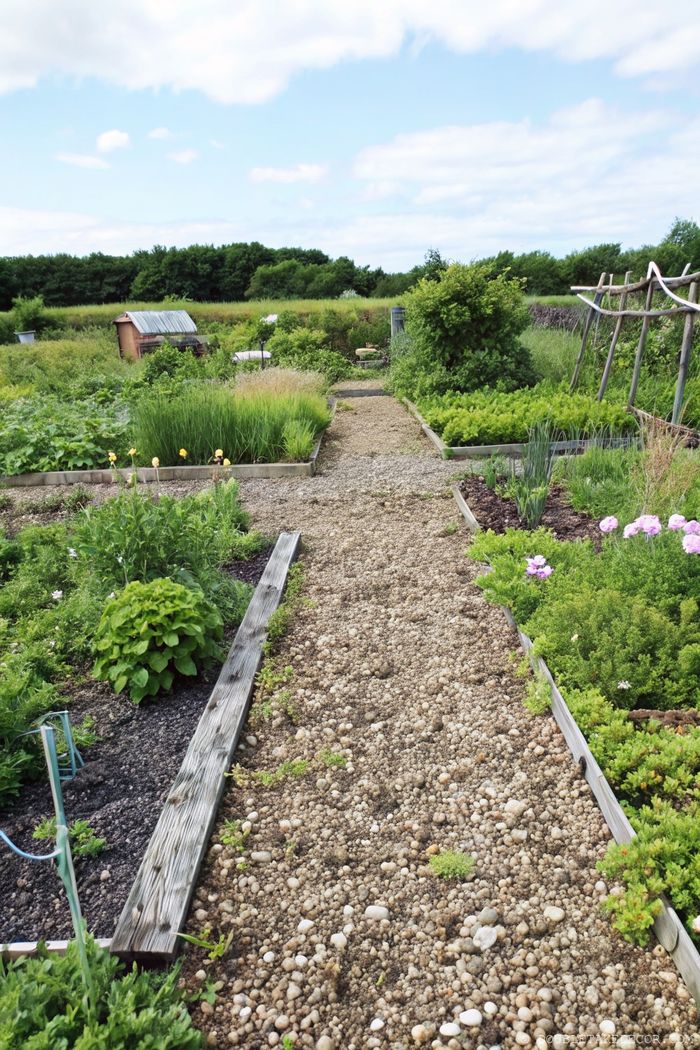
Enhance your garden’s accessibility with gravel pathways bordered by wooden planks. This practical edging solution clearly defines planting zones while providing easy maintenance. Use pressure-treated lumber for longevity and fill with fine gravel for drainage. This combination offers both structure and natural appeal, perfect for community or home gardens.
Design Edible Garden Borders That Blend Functionality with Beauty
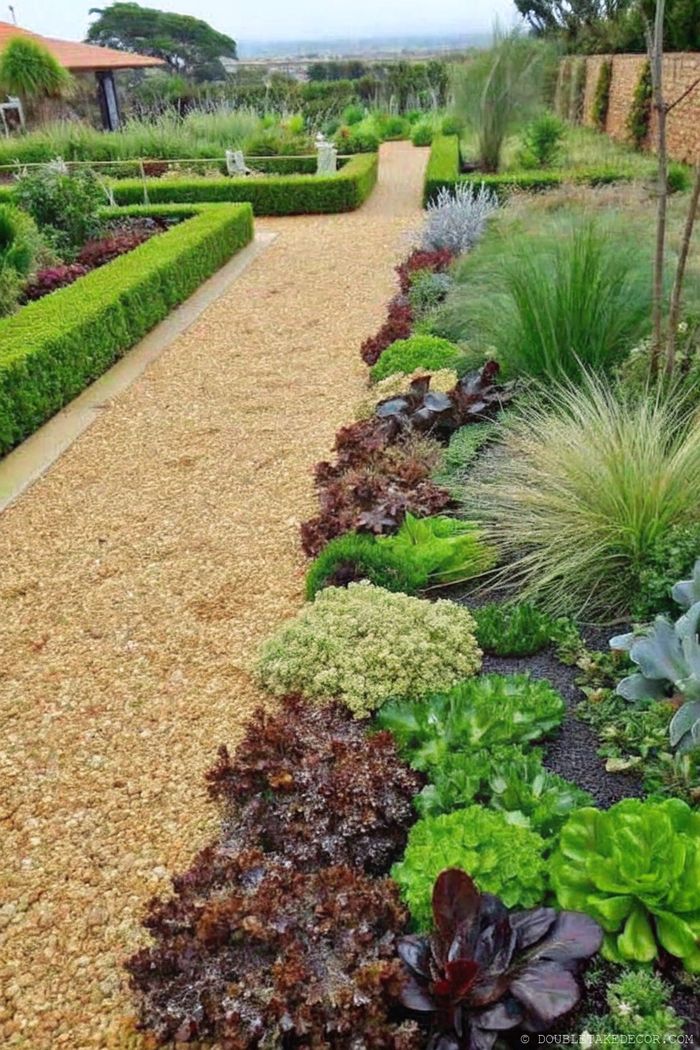
Create stunning garden edging using edible plants like colorful lettuces and herbs alongside ornamental varieties. Line your gravel pathways with these practical borders to maximize growing space while defining garden zones. Trim regularly to maintain crisp lines and prevent overgrowth. This approach delivers both visual appeal and harvestable produce throughout the growing season.
Enhance Garden Beds with Rustic Wooden Edging
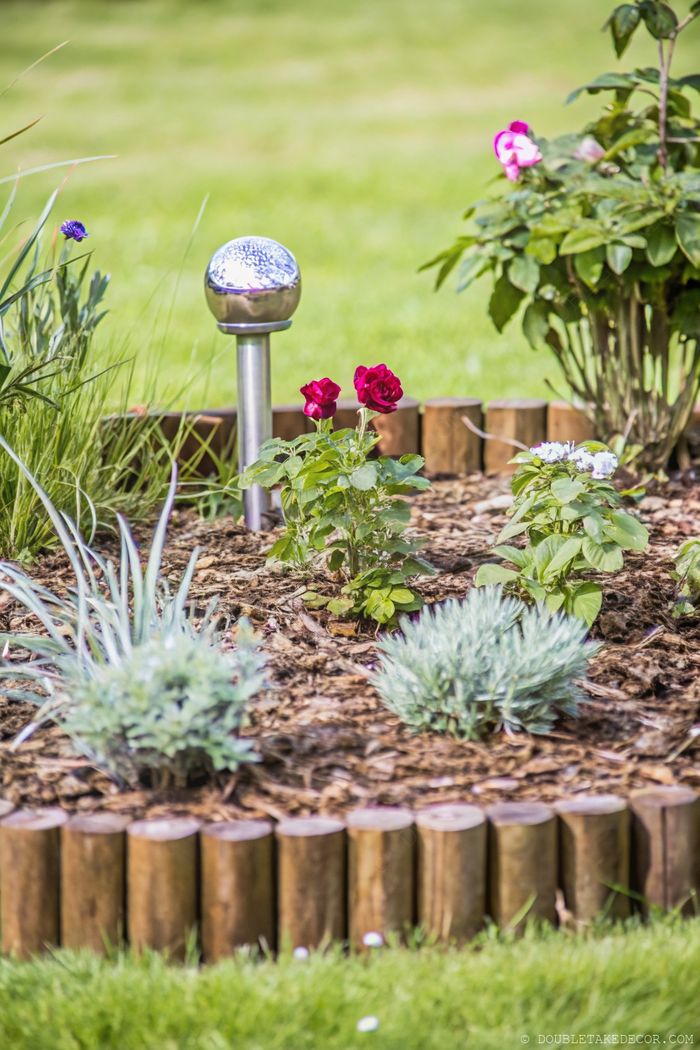
Create definition and charm by installing rustic wooden borders around your flower beds. This natural edging contains mulch effectively while providing a warm contrast to vibrant blooms. Position decorative solar lights within the bed for evening ambiance. For best results, use pressure-treated lumber or cedar to extend the life of your wooden edging against soil contact.
Elegant Curved Border Edging with Floral Accents
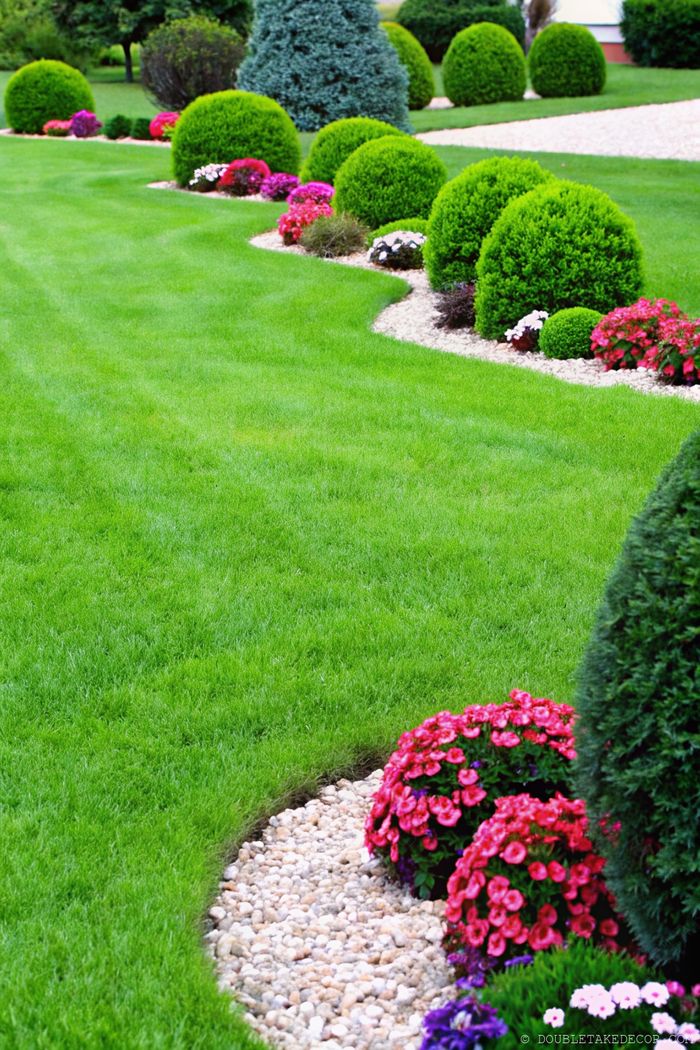
Create sophisticated garden borders by combining curved edging with gravel pathways. Plant colorful flower beds along these borders, using pink, white, and purple blooms to contrast beautifully with your lawn. Position round shrubs as focal points for depth. This design not only enhances accessibility but also establishes distinct zones in your landscape.
Craft a Rustic Woven Branch Fence for Natural Garden Boundaries

Create an enchanting garden border with a woven branch fence that adds rustic charm to your landscape. Collect fallen branches of similar thickness and weave them horizontally between vertical stakes for a sustainable boundary. This permeable edging allows climbing plants to intertwine naturally while defining garden zones. Use thicker branches for structural posts and thinner ones for weaving to ensure durability.
Create Cobblestone-Bordered Flower Beds for Structured Elegance
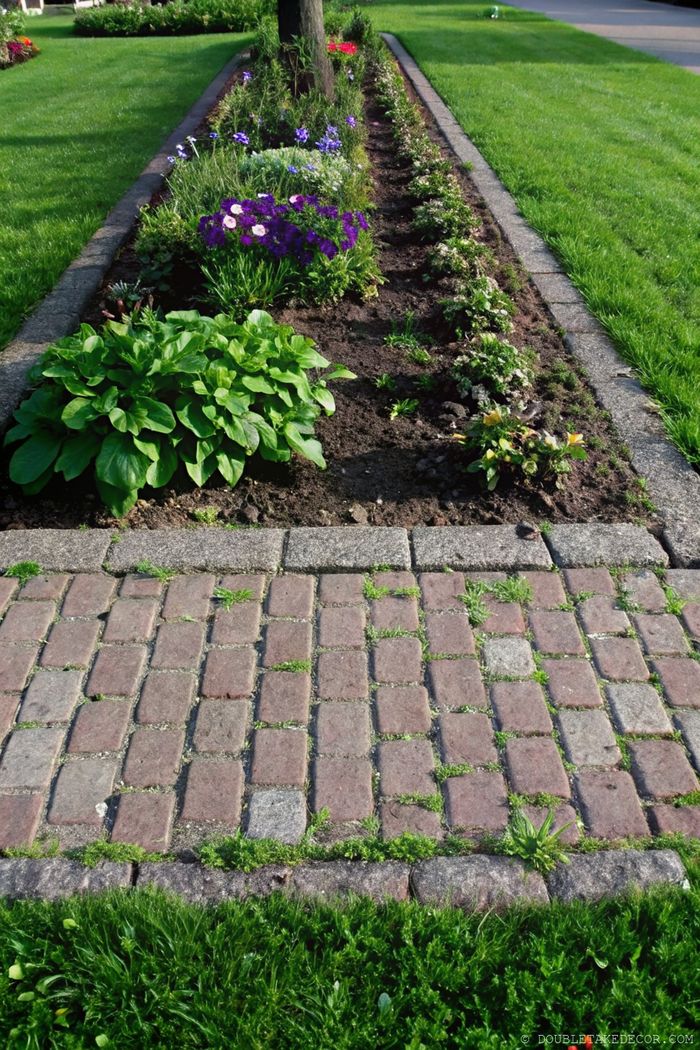
Define your garden’s personality with a rectangular flower bed bordered by stone edging. The cobblestone path alongside adds structured charm while providing practical access. Arrange colorful blooms in varying heights for visual interest. Ensure proper spacing between stones to prevent weed growth and maintain clean lines. This combination of hardscaping and vibrant plantings creates a polished, professional garden design.
Create a Captivating Pebble Pathway with Natural Stone Edging

Define your garden’s flow with this elegant pebble pathway bordered by larger stones for structural integrity. The contrasting elements—smooth pebbles against sturdy stone edges—create visual interest while maintaining a natural aesthetic. Position colorful flowers alongside the path to add vibrant focal points. This low-maintenance design works wonderfully in both formal and casual garden settings.
Repurpose Glass Bottles for Charming Garden Edging

Transform discarded glass bottles into an eye-catching garden border. Embed bottles upside down, nestling them securely in soil for stability. Choose colored glass for vibrant sunlight effects. Pair with white gravel for striking contrast against your garden bed. This eco-friendly solution not only defines spaces beautifully but also gives old bottles new purpose in your landscape.
Create Elegant Stone Pathways for Garden Definition
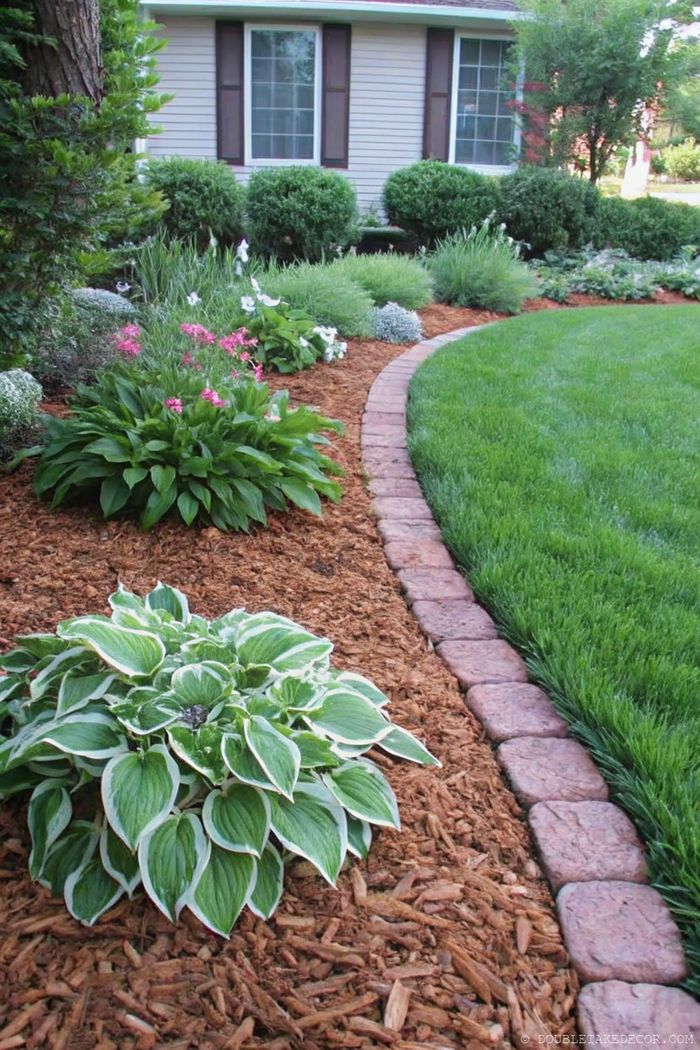
Enhance your garden’s structure with curved stone pavers that naturally guide the eye through your landscape. Use rich brown mulch to define planting areas and create contrast against vibrant foliage like variegated hostas. Combine different textures and heights in your plantings for visual interest. This professional approach not only improves curb appeal but creates distinct garden rooms.
Enhance Your Garden with a Gravel Pathway Framed by Vibrant Floral Borders
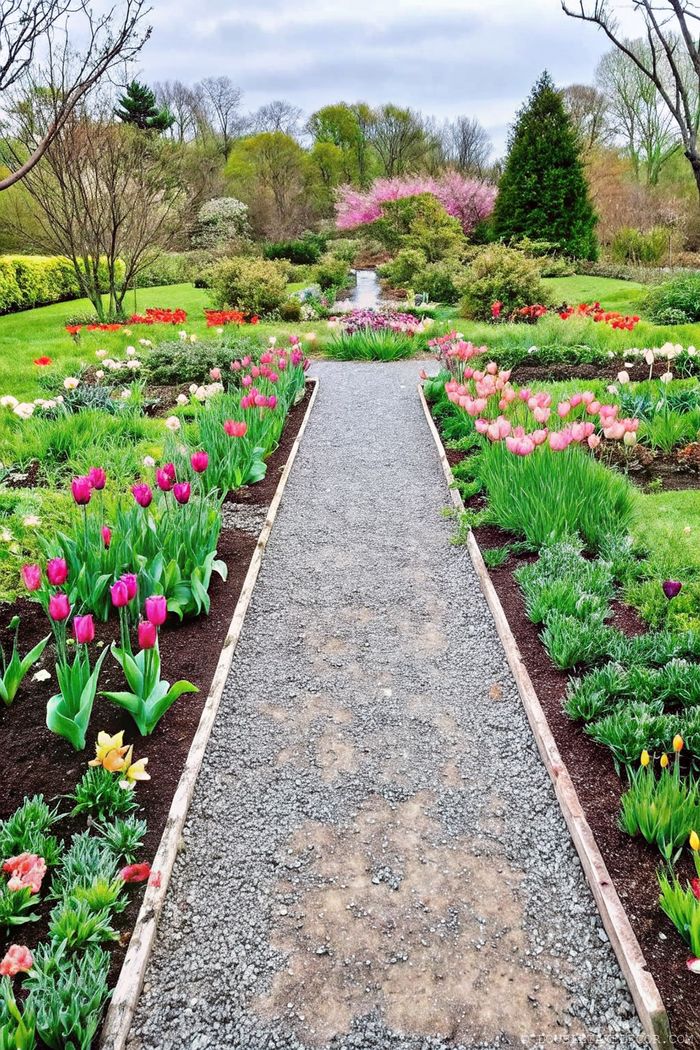
Create a striking focal point by installing a simple gravel walkway with tulip borders on either side. Use dark mulch to make flower colors pop and ensure a clean edge between path and plantings. Plant tulips in color-coordinated groups for maximum visual impact, and incorporate evergreen shrubs for year-round structure. This classic design works in nearly any garden size.
Define Garden Spaces with Natural Gravel Pathways
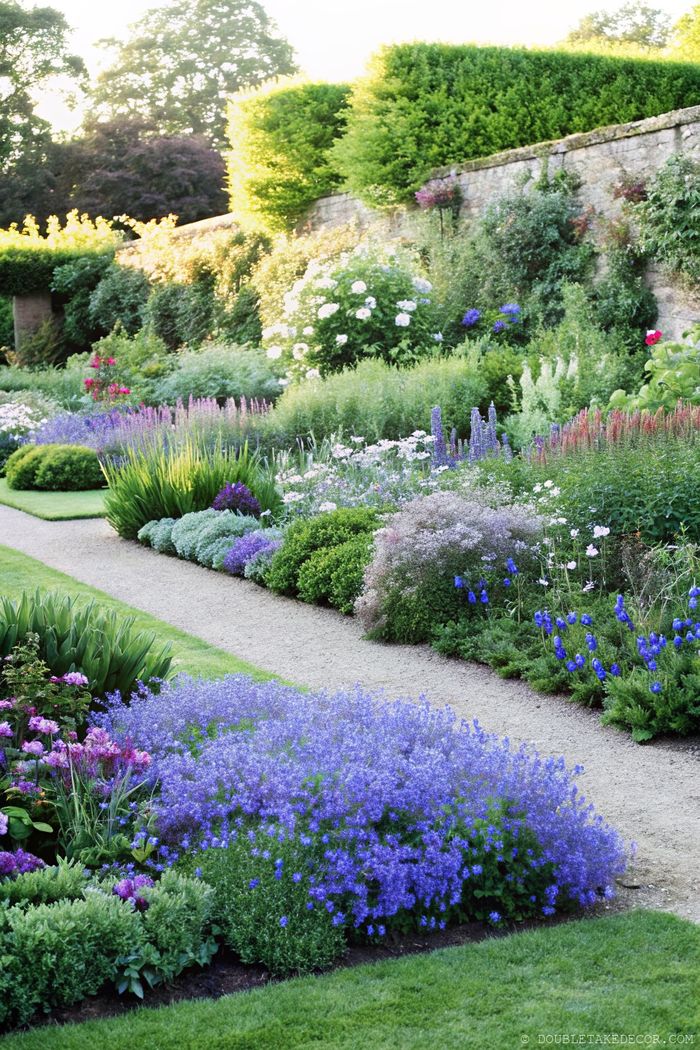
Create elegant transitions between garden areas using curved gravel pathways. Border these walkways with complementary purple, pink, and white blooms for visual contrast. For best results, maintain distinct edges between gravel and plant beds to prevent material migration. This approach offers excellent drainage while providing a practical, low-maintenance solution for garden traffic patterns.
Create Elegant Curves with Natural Stone Edging
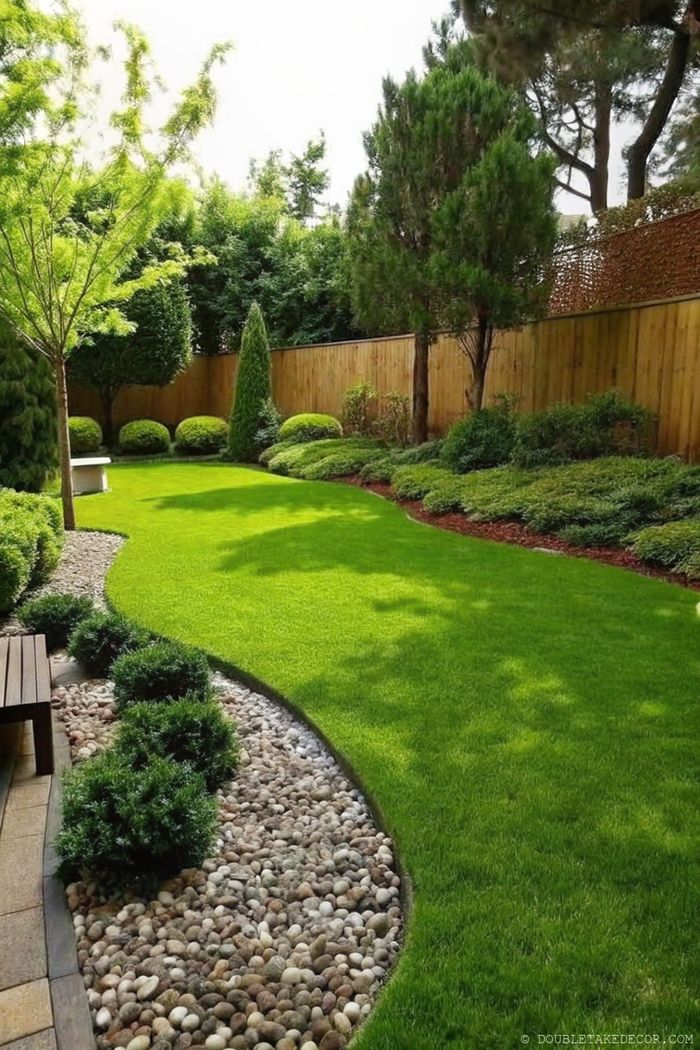
Define your lawn’s shape with smooth pebble edging along curved pathways. This natural border creates visual interest while keeping grass from encroaching into garden beds. Install a shallow trench first, then position stones for stability. The gentle curve design guides the eye through your garden landscape while providing a low-maintenance, permanent solution.
Create a Winding Stone Pathway to Define Garden Edges
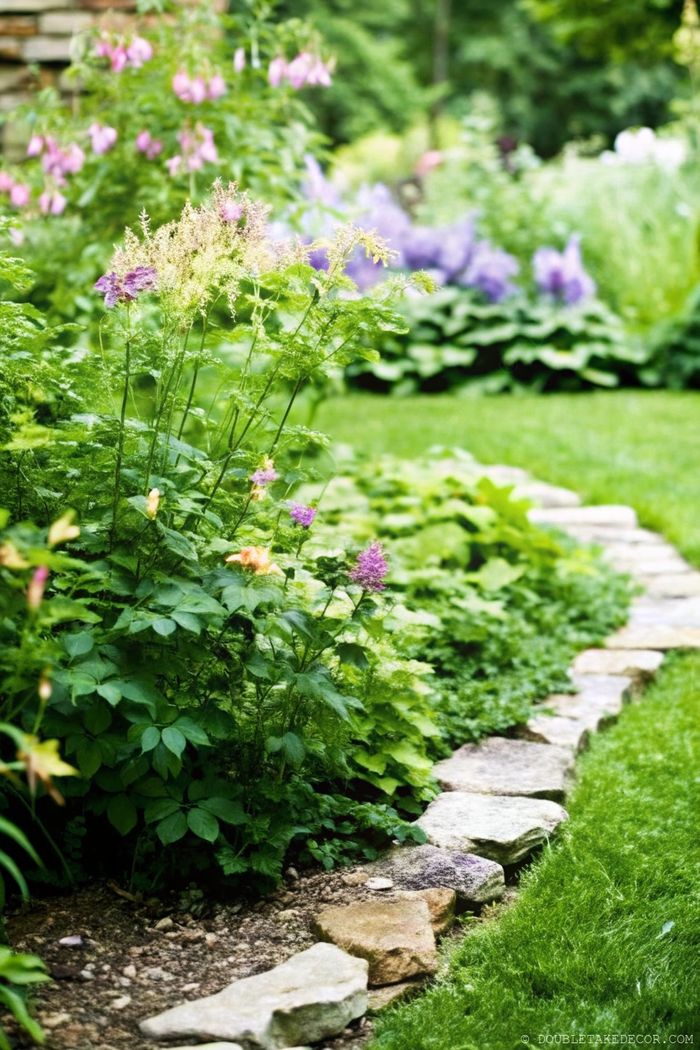
Install irregularly shaped stones as an elegant border between your lawn and flower beds. This natural-looking pathway not only provides functional access to your garden but also prevents grass from encroaching on your plants. Select stones that complement your existing landscape and arrange them with slight gaps to allow for proper drainage. Perfect for creating visual interest in any garden size.
Elegant Stone Border Creates Perfect Garden Definition
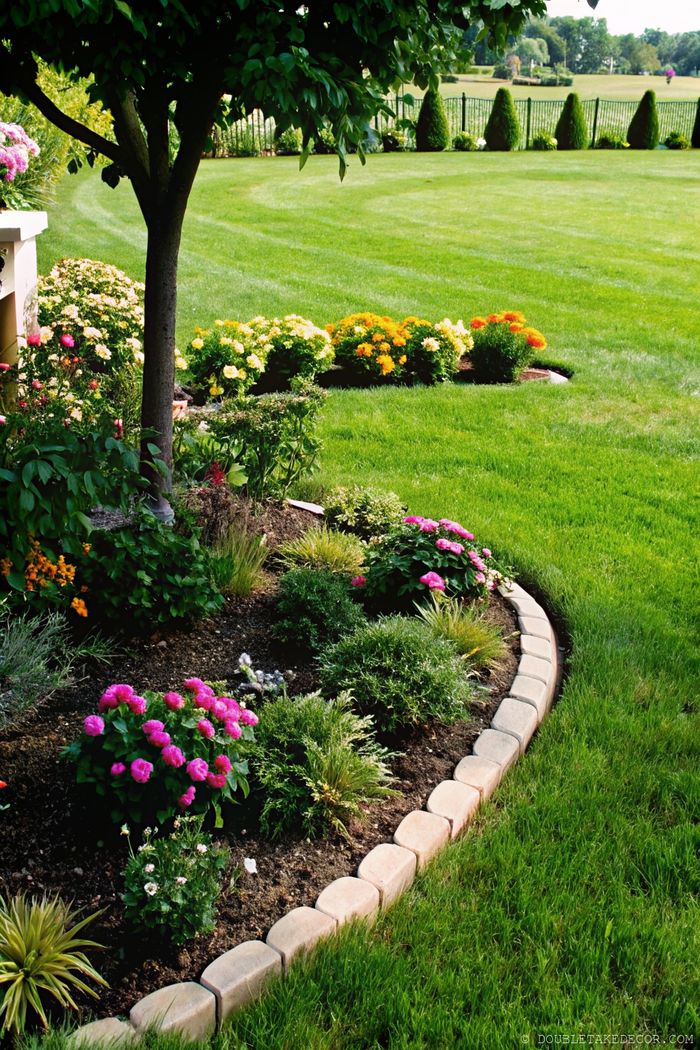
Install decorative stone edging to create a clean separation between your lawn and flower beds. This professional-looking border prevents grass from encroaching while highlighting your colorful plantings. Choose stones with complementary colors to your garden palette for a cohesive look. The curved design adds visual interest and frames the vibrant blooms beautifully.
Natural Stone Tiles Create an Elegant Garden Pathway

Elevate your garden’s visual appeal with irregularly shaped stone tiles in complementary tones. Position them with slight gaps to allow ground cover to grow between, creating a seamless blend with your landscape. Use varying stone sizes for a more organic look and ensure proper foundation to prevent shifting. This curved design naturally draws visitors through your garden’s highlights.
Create a Stunning Stone Pathway with Irregular Pavers
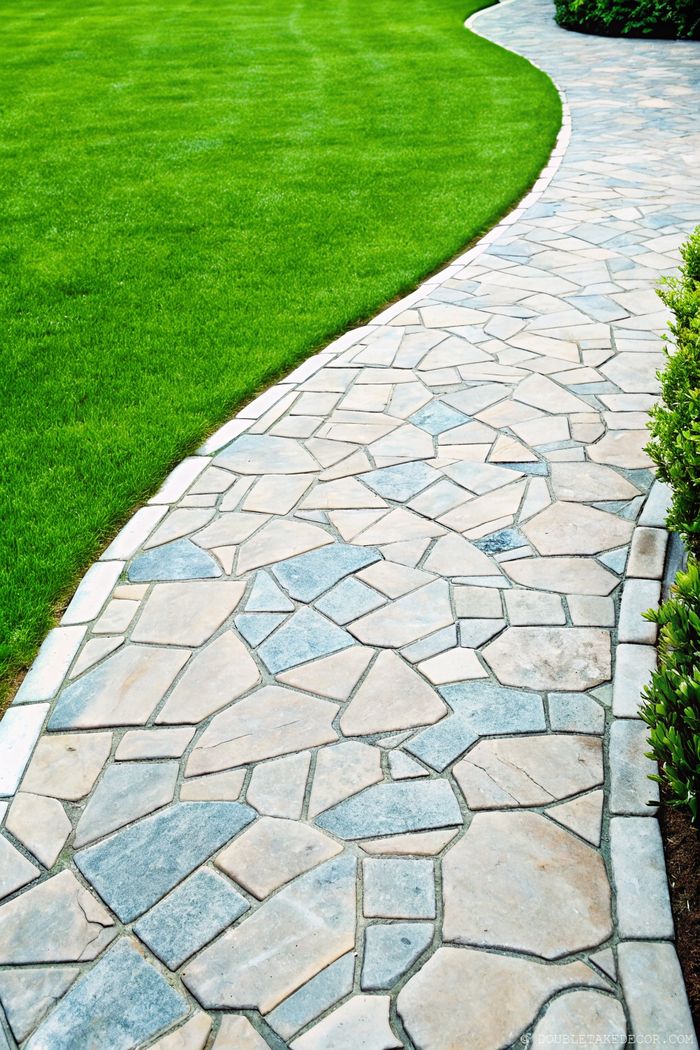
Elevate your garden’s appeal with a curved stone pathway using mixed-tone irregular pavers. Install stones close together for a cohesive look, and border with neatly trimmed hedges to frame the walkway. This design not only provides practical garden access but also creates a visually striking feature that naturally draws the eye through your landscape.
Create a Timeless Garden Path with Classic Brick Edging
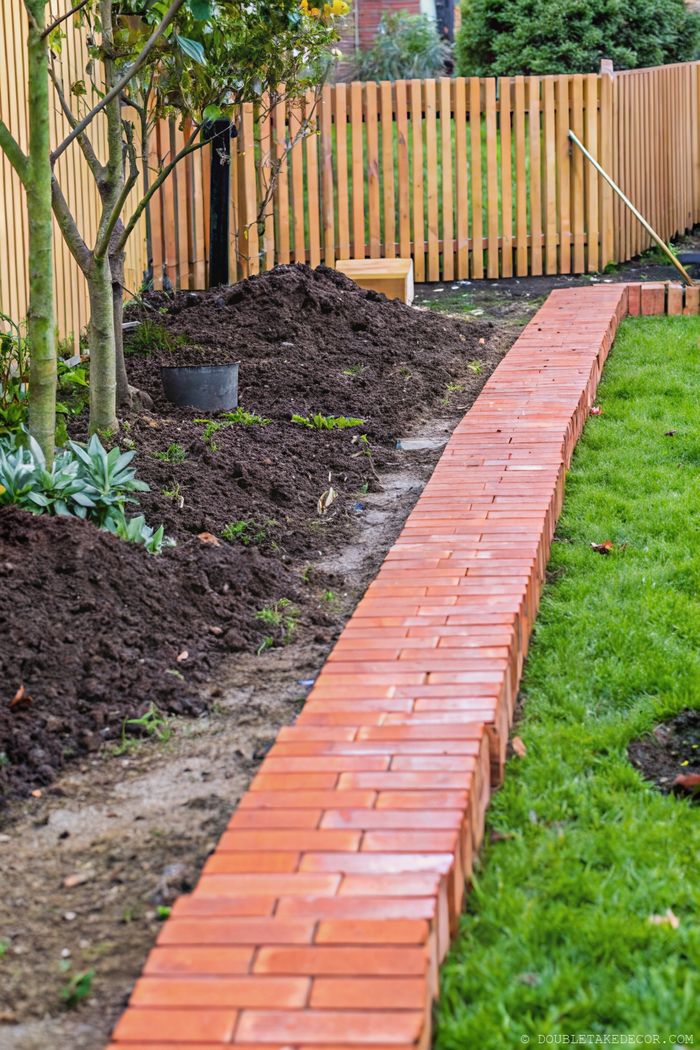
Elevate your garden’s structure with a classic brick pathway that defines walking areas while complementing natural elements. Lay bricks in a herringbone or straight pattern for stability. Ensure proper drainage by installing on a sand base. Enhance with complementary plantings along the edges for a polished, professional look that improves both functionality and aesthetics.
Create Flowing Garden Edges with Curved Gravel Pathways
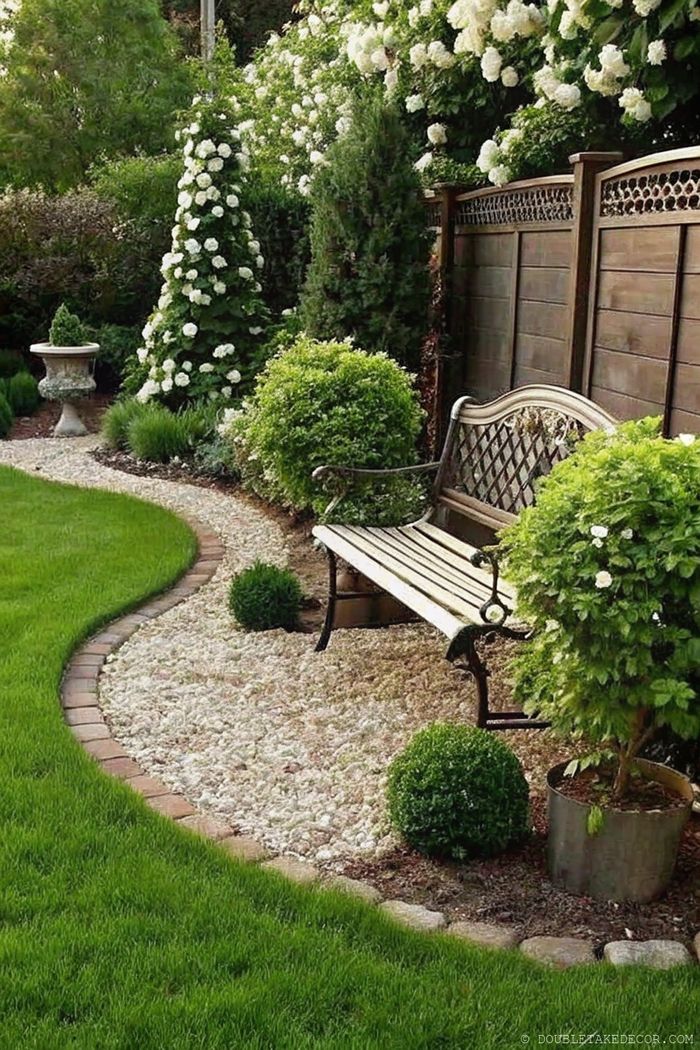
Design your garden with gracefully curved gravel pathways to add natural movement and structure. Install flexible edging materials to maintain clean lines between gravel and lawn. Position seating strategically along the path to create destinations within your garden. Enhance the borders with rounded topiary and seasonal potted plants for year-round visual interest.
Create an Elegant Curved Stone Border for Visual Interest
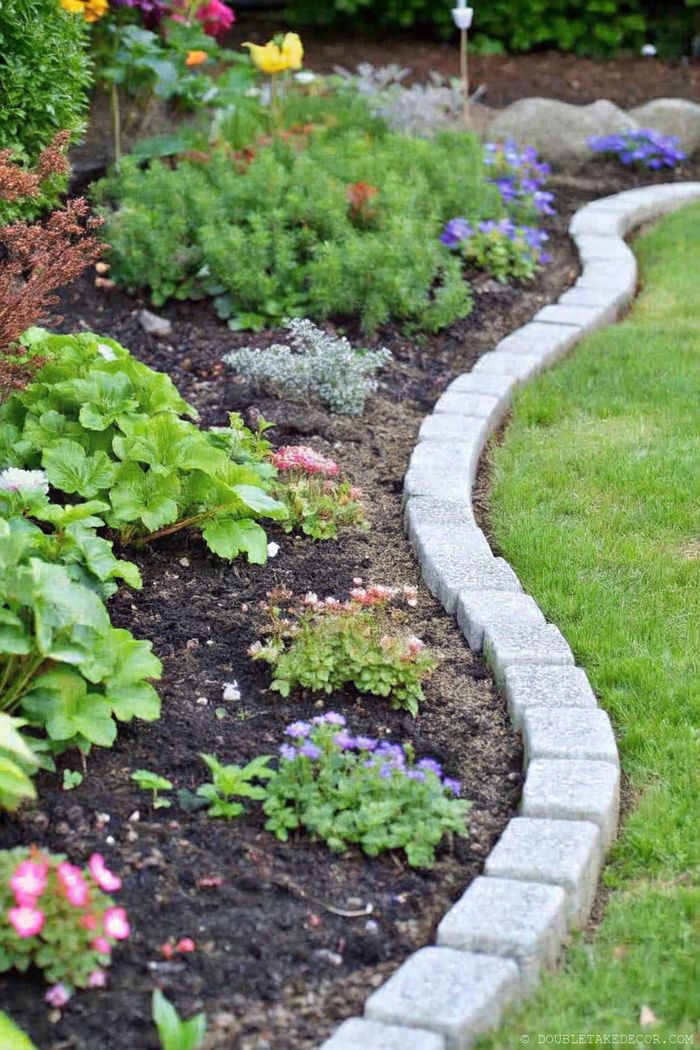
Install a curved stone border to create clean separation between your lawn and garden beds. The gentle arc adds sophisticated visual interest while effectively containing soil and mulch. Choose weather-resistant stones that complement your landscape’s color palette. This timeless edging solution requires minimal maintenance while enhancing your garden’s structure year-round.
Create a Striking Contrast with Log Fencing
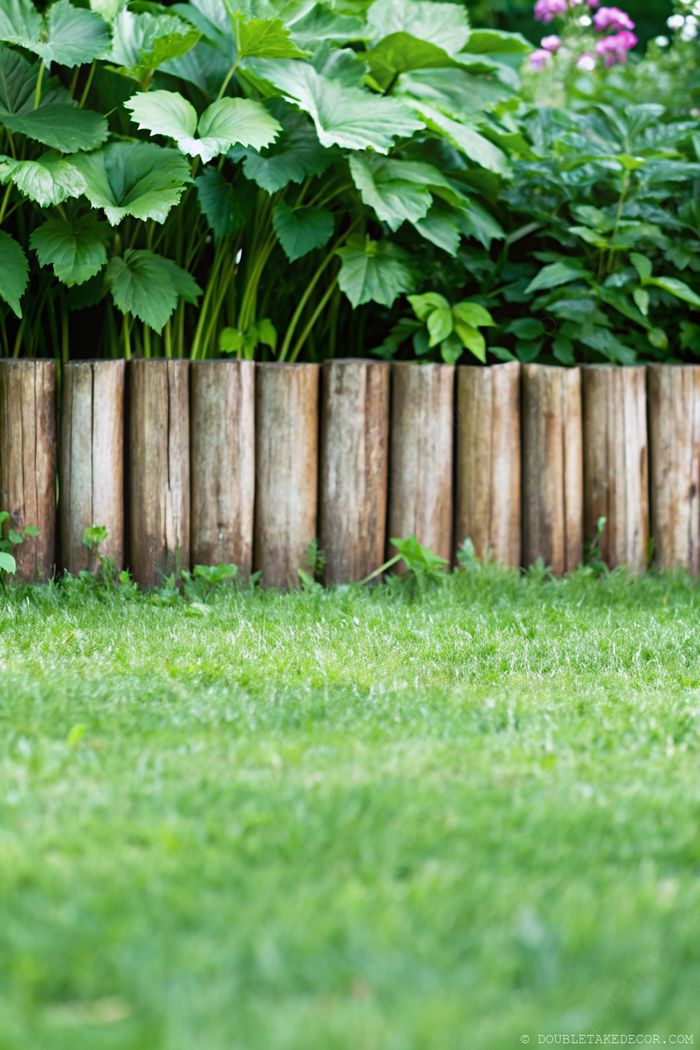
Define garden boundaries elegantly with natural log fencing that creates a rustic backdrop for your manicured lawn. Position taller plants behind the fence to add depth and visual interest. Maintain a clean edge between grass and fence line for a professional finish. This low-maintenance solution provides excellent durability while enhancing your garden’s natural charm.
FAQ
What Is Garden Edging?
Garden edging is a technique used to define the boundaries between various sections of a garden, such as flower beds, lawns, and pathways. This approach serves both functional and aesthetic purposes: it keeps soil and plants contained while enhancing the garden’s overall appearance.
A variety of materials can be employed for edging, including:
- plastic,
- metal,
- rubber,
- concrete,
- wood,
- stone.
The choice largely depends on visual appeal, durability, maintenance needs, and budget constraints.
Edging plays an integral role in organizing the garden by creating neat lines that distinguish plant areas from grass or paths. This clear separation not only enhances design but also acts as a barrier against weeds and helps prevent soil erosion by stabilizing the ground—a critical feature for gardens on slopes where runoff might be an issue.
For those looking to transform their gardens with minimal hassle or excavation work, no-dig edging offers an ideal solution. It enables quick creation of professional-looking edges using simple tools like spades or half-moon edgers along with stakes for added stability.
Selecting styles that complement your landscape design can significantly impact its appeal. For example, scalloped terracotta edges harmonize beautifully with cottage-themed settings; flexible strips allow graceful curves around intricate layouts; natural borders blend seamlessly into organic environments with subtle elegance when using living foliage alone.
Why Use Garden Edging?
Incorporating garden edging into your outdoor space brings a host of advantages:
- effectively stabilizes the ground, preventing soil erosion,
- establishes clear boundaries to keep invasive weeds at bay,
- simplifies maintenance and keeps your garden looking neat,
- lends a professional touch with sharp lines that neatly separate flower beds from pathways,
- significantly boosts the visual appeal of your garden.
With a structured layout, gardens become easier to maintain and care for. Moreover, defining distinct areas in your garden with edging enhances planning and organization for planting schemes. This clarity improves overall design while promoting healthy plant growth by keeping planting zones free from grass or intrusive plants.
Materials such as plastic, metal, or decorative concrete offer diverse choices for edging. These options add character and meet practical requirements like durability and ease of installation—with some even providing no-dig solutions to save time and effort. Ultimately, using garden edging transforms outdoor spaces into well-organized and attractive areas that require minimal upkeep.
How Does Landscape Edging Enhance Your Garden?
Landscape edging not only provides a clean finish to gardens but also defines clear boundaries. By distinguishing perennials from annuals, it creates an organized and tidy appearance. This arrangement benefits plant health by maintaining distinct soil types and reducing root competition, which encourages thriving growth. Additionally, landscape edging boosts the garden’s visual appeal while simplifying maintenance, making it both more attractive and easier to manage.
What Are the Benefits of Using Edging in a Vegetable Garden?
Edging your vegetable garden comes with a host of benefits:
- clearly defines planting beds, creating distinct boundaries that simplify maintenance and enhance the garden’s overall look,
- helps keep weeds at bay by acting as a barrier against invasive plants seeking to encroach on your vegetable areas,
- plays a vital role in preserving soil health by preventing erosion,
- keeps topsoil intact even during heavy rain or watering sessions,
- manages water runoff efficiently by channeling excess water away from vulnerable zones while retaining moisture within the planting beds.
This clarity in structure is essential for maintaining nutrient-rich soil, crucial for healthy plant growth.
Using materials like plastic or stone for edging not only tidies up your garden but also enhances plant vitality and supports efficient water management—essential elements for thriving vegetable gardening.
How Can Edging Help Prevent Soil Erosion?
Edging is essential in stopping soil erosion, especially in sloped gardens. Acting as a barrier, it keeps the soil steady and minimizes the risk of topsoil being washed away during heavy rain or watering. This stability is vital for maintaining nutrient-rich soil, crucial for healthy plants. By installing edging along slopes and paths, gardeners can control water runoff and protect plants from erosion damage. Opting for materials like stone or concrete enhances durability and boosts the effectiveness of erosion prevention.
How Can Edging Improve Water Runoff Management?
Edging plays a crucial role in managing water runoff by guiding excess water away from vulnerable areas, which helps prevent flooding and erosion. Properly installed garden borders create channels that steer water flow, avoiding unwanted pooling. This method also retains moisture in planting beds, ensuring plants receive adequate hydration without becoming overly saturated. Durable materials like concrete or stone are particularly effective for edging, as they withstand heavy water flow and maintain their structural integrity while enhancing runoff control.
What Are the Different Types of Garden Edging Materials?
Garden edging materials come in a variety of types, each offering unique benefits and aesthetics:
- plastic edging is lightweight and flexible, making it easy to shape around garden beds,
- metal options like steel or aluminum provide a durable and modern appearance,
- rubber edging, made from recycled materials, offers an eco-friendly solution that endures the elements well,
- concrete edging stands out with its strength and decorative designs, such as charming scalloped patterns that enhance pathways and flower beds,
- wood brings a natural appeal; landscape timbers or logs create rustic borders that blend seamlessly into the environment,
- stone edging, using either natural stones or manufactured blocks, delivers a classic look perfect for traditional gardens.
Each material has its own merits:
- plastic is both affordable and versatile,
- metal offers longevity,
- rubber requires minimal maintenance,
- concrete ensures stability,
- wood exudes warmth,
- stone contributes timeless elegance.
Selecting the right garden borders involves considering your preferred style, budget constraints, desired level of upkeep, and overarching landscape goals.
How to Choose the Right Edging Material for Your Garden?
Selecting the perfect edging material for your garden involves weighing a few essential factors to satisfy both style and practical needs. Begin by assessing how durable different materials are. Metal options like steel or aluminum provide a sleek, modern appearance and are built to last, whereas wood offers a more natural vibe but might require additional upkeep.
Consider the visual appeal next. Opt for materials that harmonize with your garden’s overall design:
- decorative concrete or stone can add a touch of elegance,
- recycled rubber or plastic is both cost-effective and environmentally friendly.
Maintenance is another crucial aspect. Generally, rubber or plastic demands less care compared to wood, which may need regular treatments to ward off decay. Your budget will also play a role in decision-making:
- plastic and rubber tend to be more affordable choices,
- stone and metal might stretch the wallet further.
If you’re thinking about installing the edging yourself, consider DIY-friendliness. Flexible plastic is ideal for such projects due to its easy maneuverability, unlike heavier materials like concrete that could require professional assistance.
By considering these elements—durability, aesthetics, maintenance requirements, budget considerations, and DIY ease—you can select an edging material that enhances your garden’s charm and functionality beautifully.
What Styles of Edging Are Available for Different Garden Aesthetics?
Garden edging offers a variety of styles to elevate the appearance of your outdoor spaces.
- scalloped terracotta edging, with its classic design and warm, earthy tones, perfectly complements cottage gardens,
- sleek flexible strip edging, an excellent choice for modern landscapes, effortlessly creates smooth curves and adapts to complex layouts,
- for those prioritizing both durability and aesthetics, decorative concrete edging provides a range of patterns and textures that suit both formal and casual settings.
Incorporating these diverse styles allows you to transform your garden to align with existing themes. Whether you’re aiming for rustic charm or contemporary elegance, choosing the right garden borders helps achieve your desired aesthetic while also serving practical functions like defining planting areas or pathways effectively.
What Are Some Popular Edging Styles?
Gardens frequently showcase a variety of edging styles, including:
- natural borders,
- gravel edges,
- decorative garden accents.
Natural borders employ plants to create seamless transitions, ideal for organic garden designs. Meanwhile, gravel edging is incredibly versatile; its tidy appearance and low maintenance make it suitable for both formal and informal settings. Decorative garden borders enhance visual interest by incorporating creative designs using materials like stone or wood to craft unique patterns. These diverse styles cater to various preferences, allowing gardeners to personalize their landscapes while establishing functional boundaries.
What Are the Advantages of No-Dig Edging?
No-dig edging is a popular choice among gardeners because of its convenience and efficiency. It’s extremely easy to install, requiring no extensive digging like traditional methods. This means you can set it up quickly without disturbing the soil or plants, making it perfect for preserving garden ecosystems and safeguarding plant roots.
With no-dig edging, you can achieve clean edges without the need for heavy machinery or specialized tools. Simple implements like spades or half-moon edgers paired with stakes are all you need to get professional-looking results. This method not only saves time but also cuts down on physical labor.
The materials used in no-dig edging, such as flexible strips or recycled rubber, offer durability and adaptability to various garden layouts. They complement different designs beautifully, allowing for smooth curves and natural lines that enhance outdoor spaces.
No-dig edging is a practical solution for maintaining tidy garden boundaries while reducing effort and minimizing environmental impact.
How Do You Install Garden Edging?
To start installing garden edging, first measure the area where you want to place it. This ensures you purchase the correct amount of material. Choose an edging material that complements your garden’s style and meets its needs, with options like:
- plastic,
- metal,
- rubber,
- concrete,
- wood,
- stone.
Once you’ve gathered your materials, use a spade or half-moon edger to dig a trench along the designated area. Make sure it’s deep enough to hold the edging securely but not so deep that it becomes unstable. Position the edging in the trench and adjust it for straight or curved lines as required.
To keep the edging stable and maintain clear garden borders over time, secure it with stakes or spikes. For no-dig edging solutions, simply lay them out and anchor with stakes—no extensive digging needed.
Finally, fill any gaps around the installed edging with soil or mulch. This step creates a seamless transition between areas such as flower beds and pathways while improving appearance and preventing erosion and weed growth.
By carefully following these steps, you’ll establish well-defined boundaries in your garden that enhance both its beauty and functionality.
What Tools Are Needed for Edging Installation?
To ensure a successful edging installation, you’ll need a few essential tools:
- spade shovel, crucial for digging the trenches where the edging will be placed,
- half moon edger, perfect for creating clean and precise lines along paths or garden beds,
- versatile hori hori garden knife, comes in handy for cutting through roots and tough soil,
- edging spikes, important as they secure the material, ensuring stability over time.
With these tools working together, you’ll achieve smooth installations and create well-defined, attractive garden borders.
How to Maintain Your Garden Edges?
Keeping your garden’s edges in good shape is essential for a neat appearance and to stop weeds from invading planting areas. Regular trimming helps maintain clean lines and controls plant growth. Tools like a spade or half-moon edger are handy for redefining edges as needed, ensuring a distinct boundary between the lawn and planting zones.
It’s important to inspect the edges frequently for any soil erosion, especially after heavy rain or watering. Tackling these problems promptly preserves the integrity of your garden borders. Make sure all edging materials are properly positioned and secured with stakes or spikes.
Applying mulch along the edges not only enhances the look but also conserves moisture and suppresses weed growth. For those seeking low-maintenance solutions, durable materials like stone or metal can be a great choice due to their minimal upkeep needs. By adopting these strategies, you can enjoy a well-defined and appealing garden throughout every season.
What Are Some DIY Garden Edging Ideas?
DIY garden edging offers a creative and cost-effective way to spruce up your outdoor space. By repurposing materials like old bricks or wood, you can create unique borders that not only add character but also promote sustainability.
- repurposing materials like old bricks or wood,
- flexible strip edging which is easy to install,
- decorative stones available in a variety of colors and shapes,
- weathering steel or stone pillar edging for rustic charm,
- projects that define boundaries and enhance aesthetics.
Another practical option is flexible strip edging, which is easy to install and works well with curved paths and flower beds.
For those seeking an affordable way to enhance visual appeal, decorative stones are a great choice. Available in a variety of colors and shapes, they allow for customization of your garden’s look while maintaining its functionality.
Alternatively, weathering steel or stone pillar edging can infuse rustic charm that seamlessly blends with natural landscapes.
These DIY projects provide straightforward yet impactful solutions for defining boundaries, improving organization, and enhancing the overall aesthetic without significant expense or effort.
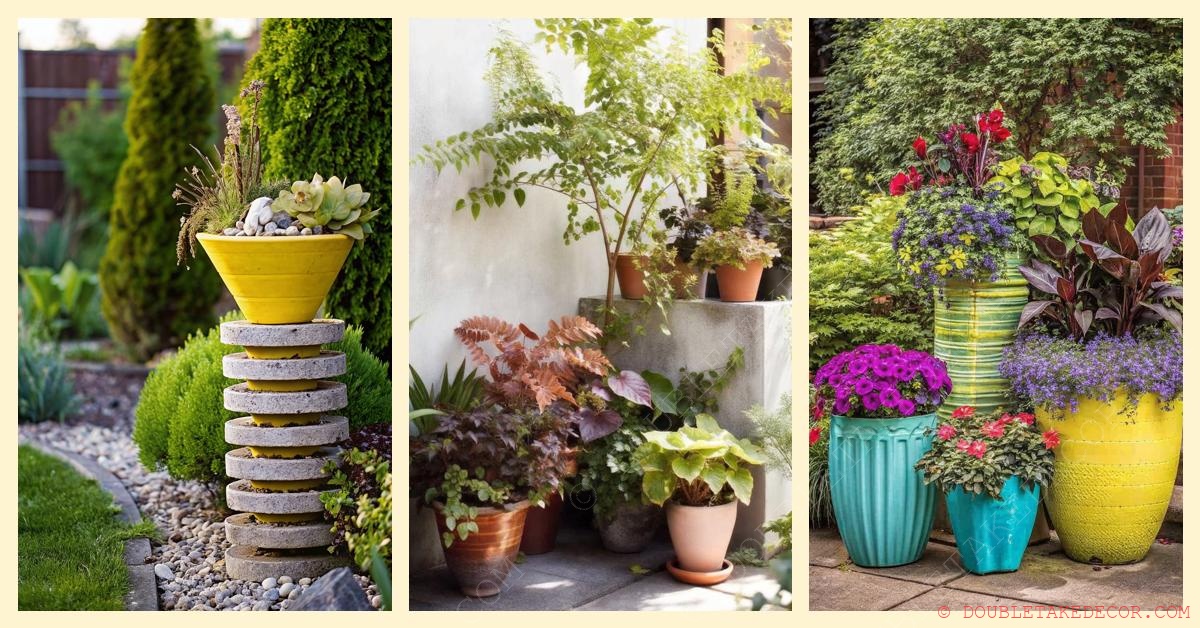
Creative Potted Plant Arrangement Ideas to Brighten Your Space
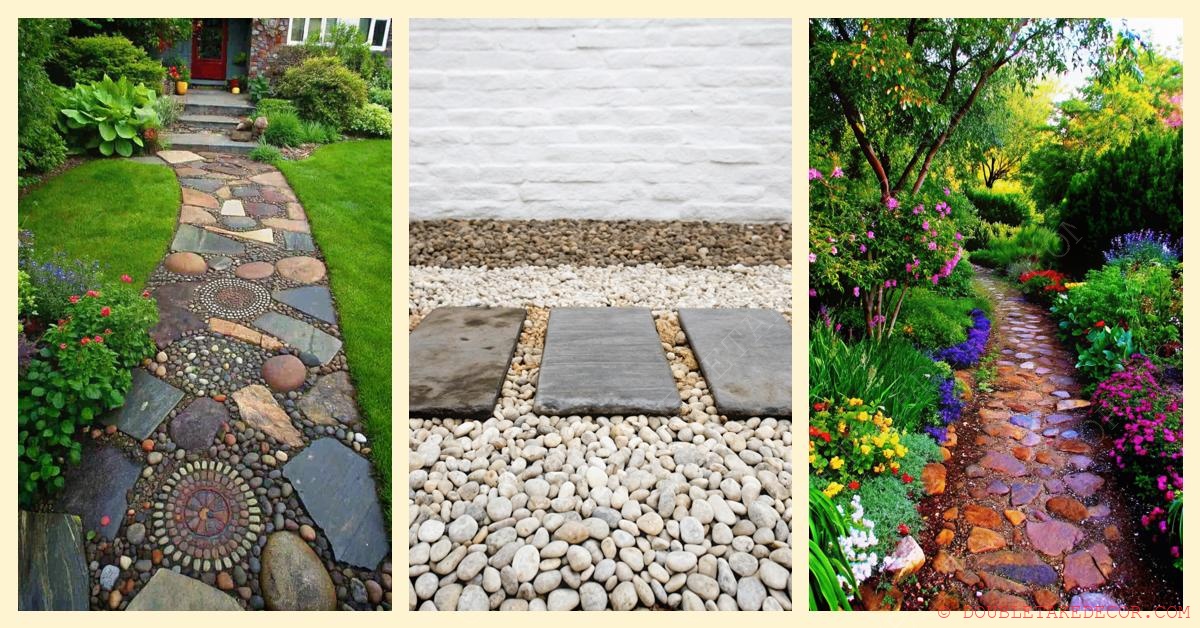
Enhance Your Garden Path with Beautiful Stepping Stones

Transform Your Backyard with a Cozy Garden Nook
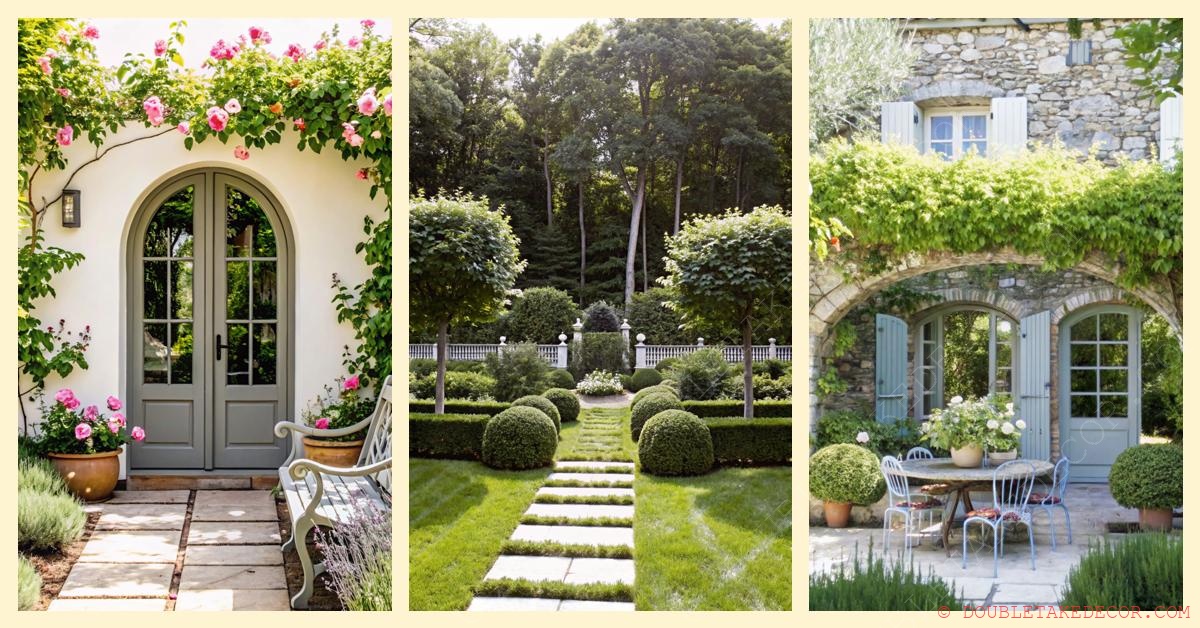
Creating Your Own French Garden: Design and Inspiration

Transform Your Curb Appeal: Inspiring Front of Home Landscaping Ideas
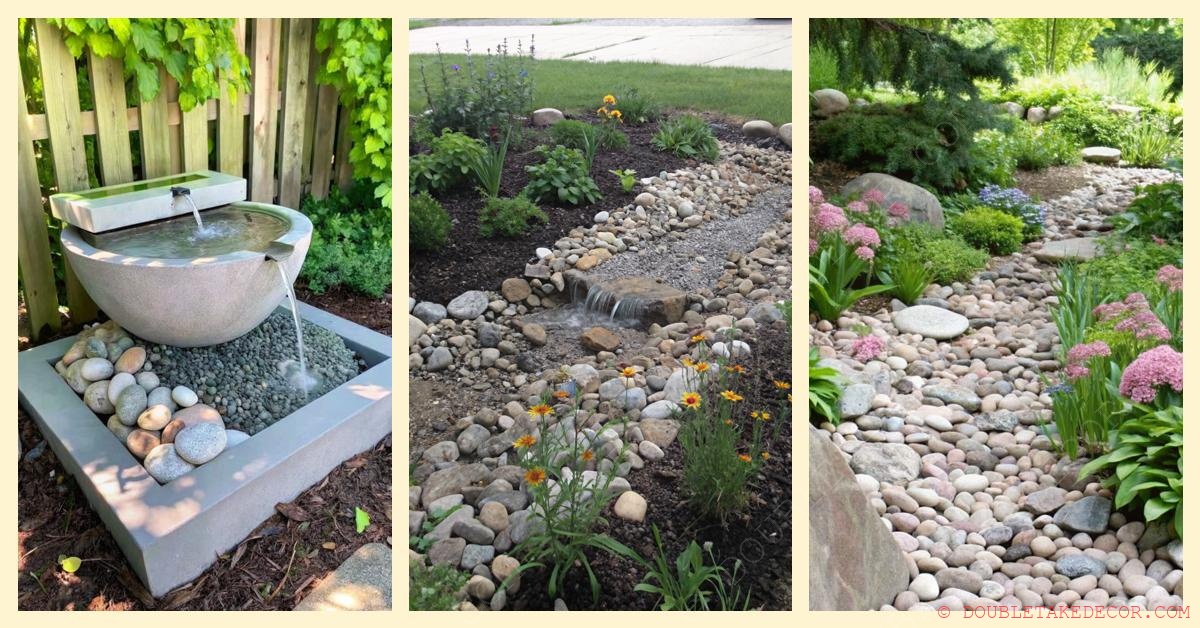
Innovative Rainscaping Ideas for a Sustainable Garden
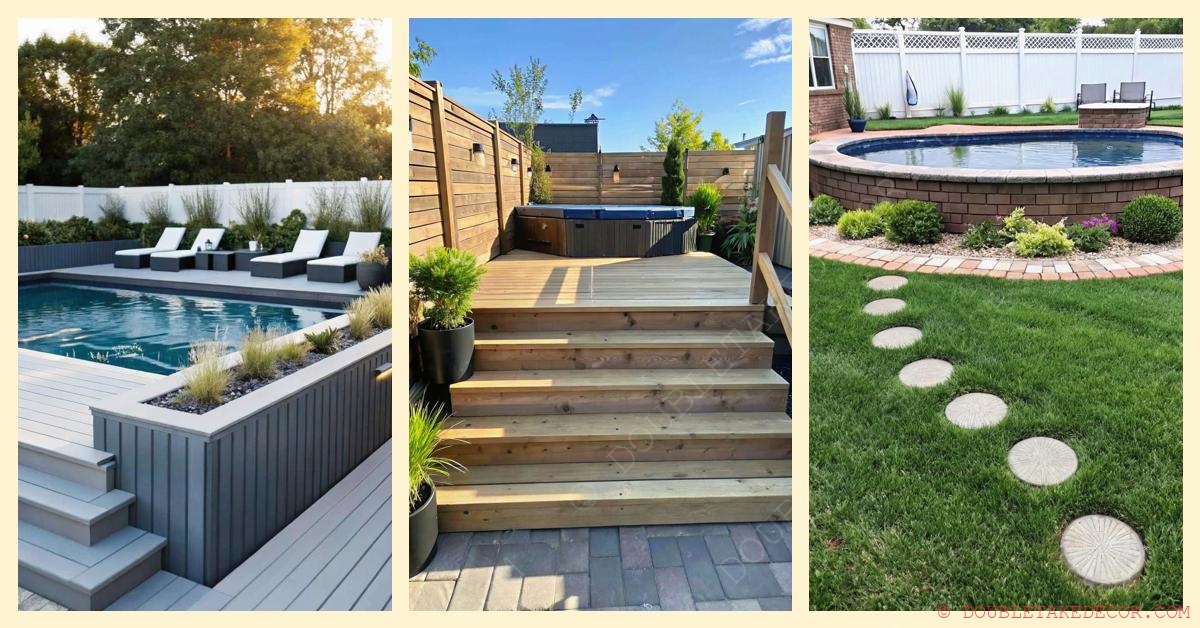
Stunning Above Ground Pool Ideas to Transform Your Backyard
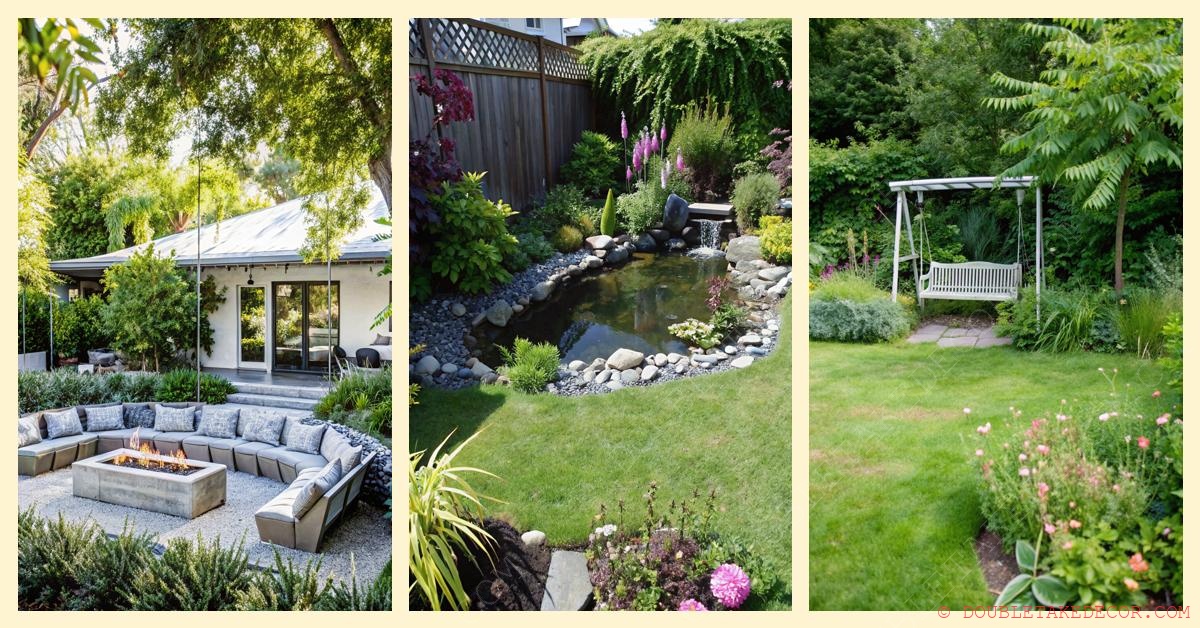
Ultimate Guide to Crafting Your Perfect Backyard Layout

Transform Your Garden with Beautiful Edging Ideas

Transform Your Outdoor Space with Shabby Chic Garden Ideas
